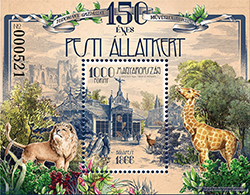
style="display:inline-block;width:728px;height:90px"
data-ad-client="ca-pub-6935274628036882"
data-ad-slot="9409061452">
1. MAGYAR - 150 éves a Budapesti Állatkert - Bélyeg vásárlás >>
2. ENGLISH - The 150 year old Budapest Zoo - Order stamp >>
1. MAGYAR - 150 éves a Budapesti Állatkert
A Magyar Posta alkalmi bélyegblokk kibocsátásával köszönti a Fővárosi Állat- és Növénykert megnyitásának százötvenedik évfordulóját. A bélyegblokkon lévő kompozíciót Gróf Lázár Kálmán: Körút az állatkertekben c. kiadványának illusztrációi ihlették. A bélyegblokkot Petényi Tibor Zoltán tervei alapján az ANY Biztonsági Nyomda Nyrt. gyártotta. Az újdonság augusztus 9-től kapható.
Az állatkert alapításának gondolata már 1820-30 körül is felmerült, de az 1848-49-es események, majd az azt követő időszak nem kedvezett a megvalósításnak. Végül néhány tudós kezdeményezésére az elképzelést tettek követték.
Az „alapító atyák" között volt Szabó József geológus, Kubinyi Ágoston, a Nemzeti Múzeum igazgatója, Gerenday József, a Füvészkert igazgatója, és az elismert zoológus és etnográfus, Xántus János, aki az első igazgatója lett az intézménynek. 1866. augusztus 9-én a déli harangszóra megnyithatta kapuit Magyarország első állatkertje, amely az akkori Pest, de a néhány évvel később egyesített és jelenkori Budapestnek is fontos nevezetessége, idegenforgalmi látványossága. Az állatállomány a hazai fajokon kívül számos ritka majom- és makifajból, sokféle papagájból, tevéből, kenguruból és más különleges állatból állt.
1876-ra elkészült az első oroszlánház, amelyben az oroszlánok mellett tigrisek laktak. Később elefánt, víziló és orrszarvú is akadt a bemutatott állatok között. Az 1873-tól illetékes igazgató, Serák Károly idején mutatványosok is helyet kaptak, ami tovább vonzotta a nagyközönséget. Működtetését 1907-ben Budapest főváros vette át és több mint négymillió aranykoronás költségen teljesen újjá is építették. Az újbóli megnyitásra 1912. május 20-án került sor, a kert igazgatója Lendl Adolf zoológus lett.
A kert ma is meglévő műemlék épületeinek többsége ekkor került átadásra. Európa egyik legszebb és legkorszerűbb ilyen intézménye volt abban a korban. Az első világháború, a gazdasági válságok sorozata, majd a második világháború szinte teljesen elpusztította. 1945. május elsején, bár csak néhány tucat állattal és romos épületekkel, de megnyitotta kapuit. A háborús károkat lépésről lépésre sikerült helyreállítani, és hamarosan komolyabb korszerűsítésekre, fejlesztésekre is lehetőség nyílt.
Az 1970-80-as évekre a megszorítások voltak jellemzőek, így a rendszerváltás idején igencsak ráfért a megújulás. Az azóta eltelt években a műemlék épületek újjászülettek, és újra régi szépségükben pompáznak, az állatok férőhelyeit korszerűsítették, és a látogatók számára is esztétikusabbá vált a környezet. A rekonstrukció a kert szinte minden egyes négyzetcentiméterét érintette. Az Állatkert napjainkra egy igazi oázissá vált Budapest szívében. A folyamatban levő fejlesztések eredményeként pedig hamarosan újabb páratlan élményekkel gazdagodhatnak az idelátogatók.
Forrás: Posta
style="display:inline-block;width:728px;height:90px"
data-ad-client="ca-pub-6935274628036882"
data-ad-slot="9409061452">
Legyél te is az Bélyeggyűjtők csoport tagja >>
2. ENGLISH - The 150 year old Budapest Zoo
Hungary Post is celebrating the 150th anniversary of the opening of the Budapest Zoo and Botanical Garden by issuing a special stamp block. The composition shown on the stamp block was inspired by the illustrations included in the publication by Count Kálmán Lázár entitled Körút az állatkertekben (Zoo tours). The stamp block was produced by ANY Biztonsági Nyomda Nyrt., based on the plans by Tibor Zoltán Petényi.
The idea of opening a zoo first emerged around 1820-30, but the events that took place in 1848-49 and the following period did not help the realisation of the zoo. Finally, at the initiative of a few scientists, the idea was followed up by action. Among the "founding fathers" were József Szabó, geologist,
Ágoston Kubinyi, the Director of the National Museum, József Gerenday, the Director of the Botanical Garden of Budapest and János Xántus, a recognised zoologist and ethnographer, who then became the first director of the Budapest Zoo. On 9 August 1866 the first Hungarian zoo opened its gates to the sound of the midday bell.
Besides Hungarian species the zoo housed several rare species of monkeys, lemurs, parrots, camels, kangaroos and other special animals. The first lion house was opened in 1876 with lions and tigers. An elephant, a hippopotamus and a rhinoceros joined later on. From 1873, during the mandate of director Károly Serák, performing artists were also invited, who attracted even more visitors. In 1907 the operation of the zoo was taken over by the capital city of Budapest, and more than four million gold crowns were spent on its complete reconstruction.
The zoo was reopened on 20th May 1912 with a new director called Adolf Lendl, a zoologist. Most of the historic buildings of the park were opened in those days. The institution was one of the most beautiful and modern zoos in Europe. However, it was nearly completely destroyed in World War I, by the subsequent economic crisis series and then in World War II. Despite this, on 1 May 1945 it opened its gates again with a mere few dozen animals and dilapidated buildings.
The war damage was restored step by step, and soon major modernizations and developments could also be realised. The 1970s and 1980s were primarily determined by constraints, so renovations did not take place until the change of the political regime. Since then the listed buildings have been reconstructed and now they can be seen in their old splendour again.
The dwelling places of the animals have been modernized and made to look more aesthetic to the visitors too. The reconstruction work affected every square centimetre of the zoo. By now the zoo has become a real oasis in the heart of Budapest. As a result of the developments currently in progress, visitors can have further unique experiences again soon.
Source: Hungary Post











